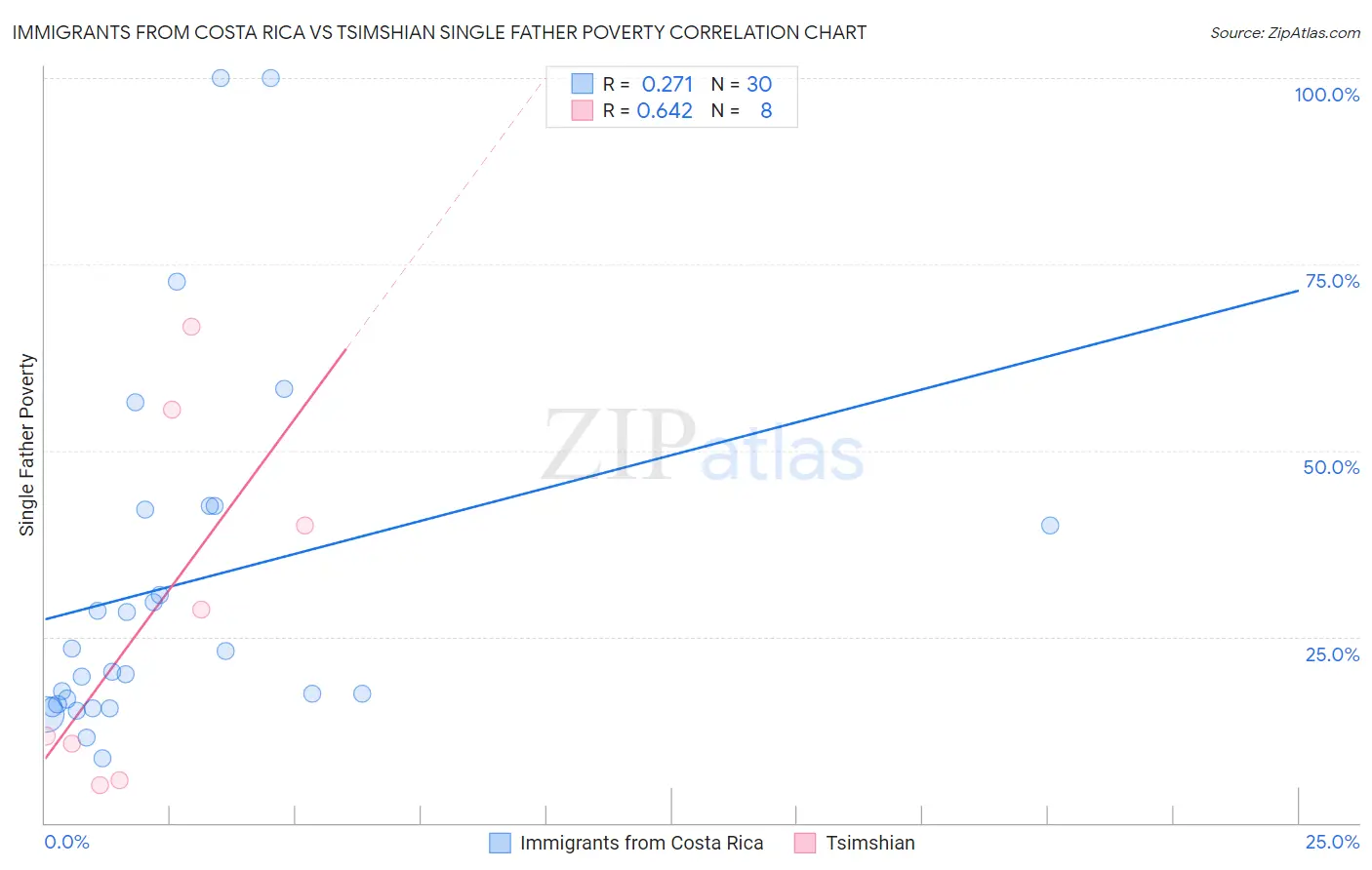Immigrants from Costa Rica vs Tsimshian Single Father Poverty
COMPARE
Immigrants from Costa Rica
Tsimshian
Single Father Poverty
Single Father Poverty Comparison
Immigrants from Costa Rica
Tsimshian
16.3%
SINGLE FATHER POVERTY
55.7/ 100
METRIC RATING
163rd/ 347
METRIC RANK
12.7%
SINGLE FATHER POVERTY
100.0/ 100
METRIC RATING
3rd/ 347
METRIC RANK
Immigrants from Costa Rica vs Tsimshian Single Father Poverty Correlation Chart
The statistical analysis conducted on geographies consisting of 176,390,678 people shows a weak positive correlation between the proportion of Immigrants from Costa Rica and poverty level among single fathers in the United States with a correlation coefficient (R) of 0.271 and weighted average of 16.3%. Similarly, the statistical analysis conducted on geographies consisting of 14,553,815 people shows a significant positive correlation between the proportion of Tsimshian and poverty level among single fathers in the United States with a correlation coefficient (R) of 0.642 and weighted average of 12.7%, a difference of 28.0%.

Single Father Poverty Correlation Summary
| Measurement | Immigrants from Costa Rica | Tsimshian |
| Minimum | 8.7% | 5.1% |
| Maximum | 100.0% | 66.7% |
| Range | 91.3% | 61.5% |
| Mean | 32.0% | 28.0% |
| Median | 21.7% | 20.1% |
| Interquartile 25% (IQ1) | 15.9% | 8.1% |
| Interquartile 75% (IQ3) | 42.0% | 47.7% |
| Interquartile Range (IQR) | 26.1% | 39.6% |
| Standard Deviation (Sample) | 24.0% | 23.9% |
| Standard Deviation (Population) | 23.6% | 22.3% |
Similar Demographics by Single Father Poverty
Demographics Similar to Immigrants from Costa Rica by Single Father Poverty
In terms of single father poverty, the demographic groups most similar to Immigrants from Costa Rica are Ugandan (16.3%, a difference of 0.010%), Guyanese (16.3%, a difference of 0.020%), Immigrants from Bangladesh (16.3%, a difference of 0.030%), Estonian (16.2%, a difference of 0.040%), and Immigrants from Europe (16.3%, a difference of 0.040%).
| Demographics | Rating | Rank | Single Father Poverty |
| Immigrants | Jordan | 66.0 /100 | #156 | Good 16.2% |
| Immigrants | Czechoslovakia | 62.8 /100 | #157 | Good 16.2% |
| Portuguese | 62.3 /100 | #158 | Good 16.2% |
| Belizeans | 59.9 /100 | #159 | Average 16.2% |
| Immigrants | Sudan | 59.8 /100 | #160 | Average 16.2% |
| Estonians | 56.7 /100 | #161 | Average 16.2% |
| Ugandans | 55.9 /100 | #162 | Average 16.3% |
| Immigrants | Costa Rica | 55.7 /100 | #163 | Average 16.3% |
| Guyanese | 55.2 /100 | #164 | Average 16.3% |
| Immigrants | Bangladesh | 55.1 /100 | #165 | Average 16.3% |
| Immigrants | Europe | 54.8 /100 | #166 | Average 16.3% |
| Yugoslavians | 53.9 /100 | #167 | Average 16.3% |
| Costa Ricans | 53.6 /100 | #168 | Average 16.3% |
| Northern Europeans | 52.8 /100 | #169 | Average 16.3% |
| Scandinavians | 52.3 /100 | #170 | Average 16.3% |
Demographics Similar to Tsimshian by Single Father Poverty
In terms of single father poverty, the demographic groups most similar to Tsimshian are Tongan (12.2%, a difference of 3.9%), Immigrants from Fiji (13.2%, a difference of 4.2%), Immigrants from Ethiopia (13.4%, a difference of 5.9%), Ethiopian (13.5%, a difference of 6.7%), and Immigrants from Taiwan (13.7%, a difference of 7.8%).
| Demographics | Rating | Rank | Single Father Poverty |
| Assyrians/Chaldeans/Syriacs | 100.0 /100 | #1 | Exceptional 11.7% |
| Tongans | 100.0 /100 | #2 | Exceptional 12.2% |
| Tsimshian | 100.0 /100 | #3 | Exceptional 12.7% |
| Immigrants | Fiji | 100.0 /100 | #4 | Exceptional 13.2% |
| Immigrants | Ethiopia | 100.0 /100 | #5 | Exceptional 13.4% |
| Ethiopians | 100.0 /100 | #6 | Exceptional 13.5% |
| Immigrants | Taiwan | 100.0 /100 | #7 | Exceptional 13.7% |
| Samoans | 100.0 /100 | #8 | Exceptional 13.8% |
| Afghans | 100.0 /100 | #9 | Exceptional 14.0% |
| Koreans | 100.0 /100 | #10 | Exceptional 14.0% |
| Filipinos | 100.0 /100 | #11 | Exceptional 14.0% |
| Immigrants | India | 100.0 /100 | #12 | Exceptional 14.0% |
| Immigrants | Philippines | 100.0 /100 | #13 | Exceptional 14.0% |
| Immigrants | Vietnam | 100.0 /100 | #14 | Exceptional 14.1% |
| Sri Lankans | 100.0 /100 | #15 | Exceptional 14.2% |